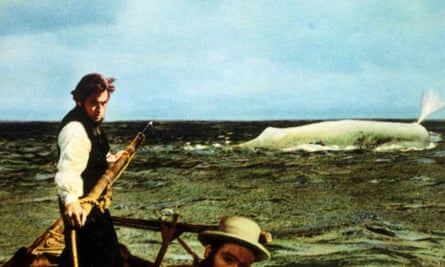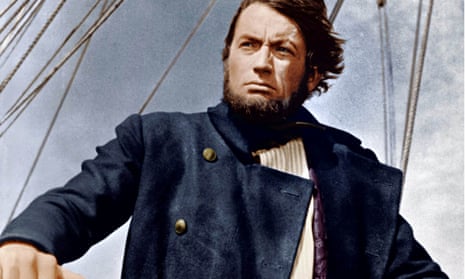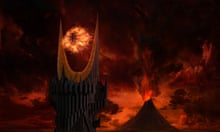The villain in Herman Melville’s Moby-Dick isn’t the monstrous White Whale, but the man that wants to kill him: Captain Ahab. Melville withholds Ahab’s appearance for well over 100 pages of his novel. At first he is only a name, then a sailor’s story, then a brooding but unseen presence, shut up in his cabin, as the Pequod sets sail from Nantucket on Christmas Day and strikes south for the whaling grounds of the Pacific. The Pequod’s shareholders are hoping for a great profit, but Ahab is only interested in a single whale among the multitudes: Moby Dick.
Ahab is an enigma whose “larger, darker, deeper part remains unhinted”. What can we say we know about him? That he is a “grey-headed, ungodly old man”. He has eyes “like powder pans”. His crew say he never sleeps, only tosses in bed. Dough-Boy the steward tells Ishmael that every morning: “He always finds the old man’s hammock clothes all rumpled and tumbled, and the sheets down at the foot, and the coverlid almost tied in knots”, and Ahab’s pillow hot to the touch, “as though a baked brick had been on it”. He has a scar, too, a “slender rod-like mark, lividly whitish”, running from head to toe. None of the crew knows where he got it, but they all know how he lost his leg. In the Pacific, a year before the events Ishmael describes in the novel, Ahab found himself surrounded by “the chips of chewed boats, and the sinking limbs of torn comrades”, all churning in the “white curds of the whale’s direful wrath”. Moby Dick took Ahab’s leg, “as a mower a blade of grass in the field”, and now the captain uses a peg leg carved from whalebone.

In the long months following this near-fatal encounter with Moby Dick, as Ahab’s ship made around the Cape for Nantucket, his “torn body and gashed soul bled into one another” and “made him mad”. His crew bound him, and straitjacketed he “swung to the mad rockings of the gales”. During the course of this long, painful journey Ahab came to fix all his hatred on the White Whale. “All that most maddens and torments,” Ishmael says, “all that stirs up the lees of things; all truth with malice in it; all that cracks the sinews and cakes the brain; all the subtle demonisms of life and thought; all evil, to crazy Ahab, were visibly personified and made practically assailable in Moby Dick”.
Ahab’s hatred is toxic: it has perverted his perception of the world, which he describes, nihilistically, as a pasteboard mask with only the void lying behind it. Yet the power of his charisma is such that he can communicate his extreme, dangerous hatred to an entire crew, even educated, sensitive and openhearted Ishmael. In the Quarter-Deck chapter, when Ahab sells the crew on their doomed mission with what one critic calls his “manipulative philosophical dialogue”, Ishmael admits that “my shouts had gone up with the rest; my oath had been welded with theirs; and stronger I shouted, and more did I hammer and clinch my oath, because of the dread in my soul. A wild, mystical, sympathetical feeling was in me; Ahab’s quenchless feud seemed mine.” Ahab is so dangerous because he can make otherwise reasonable men enlist in his unreason, including the good Nantucket Quaker Starbuck, chief mate, who tries and fails to persuade Ahab of the folly of his mission. Towards the end of the novel, all the Pequod’s mates are described almost as automata controlled by their captain: “Like machines, they dumbly moved about the deck, ever conscious that the old man’s despot eye was on them”.
“To inspire others to act on one’s obsession,” David Herd writes of Ahab, “is to become a dictator,” and it is in those passages when Ahab’s personal hatred ramifies through the crew, mobilising them to kill at his behest, that he most obviously appears to foreshadow the various 20th-century dictators and demagogues that have been compared to him. Moby-Dick has long been seen as an argument between Ishmael’s democratic instincts and Ahab’s polarising tyranny (among many other things), but Ahab’s Manichaeism, powerful as it is, cannot be sustained. In its promiscuous range of subjects, in its adoption of various registers, from shipboard manual to philosophical enquiry to natural history to Shakespearean drama, Moby-Dick is a book that repeatedly asserts, in Tony Tanner’s phrase, the “swimming intermixedness of life”. To deny that multiplicity, to crush it all down into a binary opposition, as Ahab attempts, is to risk wrecking yourself.

At last, even Ahab cannot maintain his extremist position. As the book nears its conclusion, more and more doubt burrows into his soliloquies. In the chapter entitled The Symphony, Starbuck, sensing Ahab’s uncertainty, makes a last attempt to dissuade him from his pursuit of the White Whale. But Ahab isn’t listening. Instead, he wonders if he has any control at all over his own actions. “Is Ahab, Ahab?” he asks. “Is it I, God, or who, that lifts this arm?” In these final stages, where Ahab’s growing self-awareness make him less a villain, and more like one of the flawed heroes of Shakespeare’s tragedies, he comes tantalisingly close to redemption. But instead he abdicates responsibility for his actions by invoking fate as the force that drives him on: the ship will not turn for home.
The Ahab that wins out, then, is the Ahab of the night described in The Candles, when he waves a burning harpoon above the heads of his crew. As Charles Olson describes, it is “a night of storm. The setting is Lear-like.” But unlike Lear Ahab does not “discover his love for his fellow wretches. On the contrary, this night Ahab uncovers his whole hate.” The Ahab that wins out is the Ahab of The Forge, when he baptises his newly hammered harpoon not “in the name of the father, but in the name of the devil”. The Ahab that wins out is part Macbeth, part Faust, and part Milton’s Satan. In love with his hatred, he is the most dangerous kind of leader. The kind who, when he falls, takes the whole ship down with him.




Comments (…)
Sign in or create your Guardian account to join the discussion